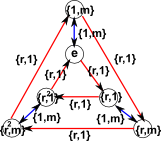Perhaps the simplest way to combine (multiply) two sets (and therefore groups) is to use the Cartesian product as explained on this page. This product produces a set from the product:
g×h = {g, h}
So the result of this product is a different type of entity than the elements being multiplied, so the multiplication is not closed, and therefore does not represent a group. The external product makes this into a group because the inputs to the multiplication are also sets:
{g, h} × {g' , h' } = {g * g' , h o h' }
where:
- × is the operation of the combined algebra.
- * is the operation of the group G.
- o is the operation of the group H which may be, or may not be, the same as *.
Example C2×C3
In order to try to understand this product of two groups lets try multiplying two very simple groups together, the simplest groups I can think of are C2 and C3. As a reminder these are the definitions of these groups individually (full definitions on this page):
C2
| generator | cayley graph | table | permutation | representation | ||||||||
|---|---|---|---|---|---|---|---|---|---|---|---|---|
| <m | m²> |
|
< ( 1 2 ) > |
|
C3
| generator | cayley graph | table | permutation | representation | ||||||||||||||||||
|---|---|---|---|---|---|---|---|---|---|---|---|---|---|---|---|---|---|---|---|---|---|---|
| <r | r³> |  |
|
< ( 1 2 3 ) > |
|
direct product C3 × C2
This gives :
| generator | cayley graph | table | ||||||||||||||||||||||||||||||||||||||||||||||||||||||||||||||||||||||||||||||
|---|---|---|---|---|---|---|---|---|---|---|---|---|---|---|---|---|---|---|---|---|---|---|---|---|---|---|---|---|---|---|---|---|---|---|---|---|---|---|---|---|---|---|---|---|---|---|---|---|---|---|---|---|---|---|---|---|---|---|---|---|---|---|---|---|---|---|---|---|---|---|---|---|---|---|---|---|---|---|---|---|
| <m,r | m²,r³,rm=mr> |  |
|
||||||||||||||||||||||||||||||||||||||||||||||||||||||||||||||||||||||||||||||
| permutation | representation | |||||||||||||||||||||||||||||||||||||||||||||||||||||||||||||||||||||||||||||||
| <(1 2 3)(4 5 6),(1 4)(2 5)(3 6)> |
|
|||||||||||||||||||||||||||||||||||||||||||||||||||||||||||||||||||||||||||||||
Note that, in addition to applying both the generators and constrains for the original groups we have had to apply an additional constraint: rm=mr. If we had not done this we would have the infinite free product.
Generating a Direct Product using a Program
We can use a computer program to generate these groups, here I have used Axiom/FriCAS which is described here.
(1) -> )r axiom/directProduct
)set output algebra off
)set output mathml on
-- first calculate C2 x C3
C2 := FiniteGroup(2,[[1,2],[2,1]],["1","m"])
Type: Type
DP := directProduct([[1,2,3],[2,3,1],[3,1,2]],["1","r","rr"])$C2
Type: Type
toTable()$DP
Type: Table(6)
setGenerators([false,true,false,true,false,false])$DP
Type: Void
PDP := toPermutation()$DP
<(1 2 3)(4 5 6),(1 4)(2 5)(3 6)>
Type: PermutationGroup(Integer)
permutationRepresentation(PDP,6)
Type: List(Matrix(Integer))
-- now calculate C3 x C2
C3 := FiniteGroup(3,[[1,2,3],[2,3,1],[3,1,2]],["1","r","rr"])
Type: Type
DP := directProduct([[1,2],[2,1]],["1","m"])$C3
Type: Type
toTable()$DP
Type: Table(6)
setGenerators([false,true,true,false,false,false])$DP
Type: Void
PDP := toPermutation()$DP
<(1 2)(3 4)(5 6),(1 3 5)(2 4 6)>
Type: PermutationGroup(Integer)
permutationRepresentation(PDP,6)
Type: List(Matrix(Integer))
(13) ->
|